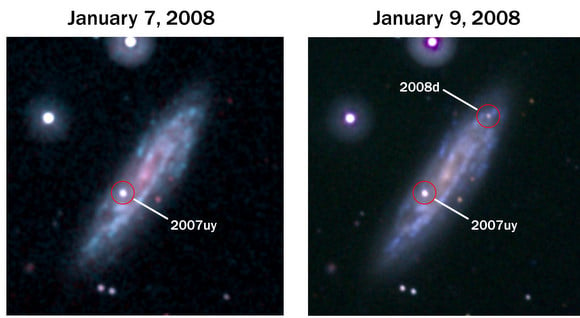The Swift satellite has made another fortuitous observation. This time, and for the first time ever, astronomers have caught a star in the act of going supernova. These stellar explosions have been observed before, but always after the fireworks were well underway. "For years we have dreamed of seeing a star just as it was exploding, but actually finding one is a once-in-a-lifetime event," says Alicia Soderberg, from Princeton University, who is leading the international group studying this explosion. "This newly born supernova is going to be the Rosetta Stone of supernova studies for years to come."
In January of 2008 Soderberg was expecting to study a month-old supernova that was already underway. But as she and her assistant studied the X-ray emissions conveyed from space by NASA's Swift satellite, they saw an extremely bright light that seemed to jump out of the sky. They didn't know it at the time, but they had just become the first astronomers to have caught a star in the act of exploding.
"In the old days -- last year -- people found supernovae by their optical light and then started to study them to understand which stars blow up, what the mechanism is and what they produce," said Robert Kirshner, a professor of astronomy at Harvard University. "But this is something new -- the X-rays come right at the beginning and provide a very early alert to the event."
Soderberg regards the discovery as a case of extreme serendipity. The satellite was pointing in the right place at the right time, she said, because she had asked Neil Gehrels, Swift's lead scientist at NASA's Goddard Space Flight Center to turn it that way to look at another supernova. And while she was away lecturing, she had asked her colleague, Edo Berger, to keep an eye on the data for her.
"It's a really lucky chain of events -- a surprise," said Soderberg, who is leading the group studying the explosion. "It was all over in a matter of minutes."
Other observatories also turned their telescopes toward this stellar explosion, making detailed observations of the event, including the Hubble Space Telescope, the Chandra X-ray Observatory, Palomar's 60- and 200-nch telescopes, the Gemini Observatory and Kitt 1 Telescope in Hawaii, and the Very Large Array and Apache Point Observatories in New Mexico. This will allow a very detailed study of this event.
A typical supernova occurs when the core of a massive star runs out of nuclear fuel and collapses under its own gravity to form an ultradense object known as a neutron star. The newborn neutron star compresses and then rebounds, triggering a shock wave that plows through the star's gaseous outer layers and blows the star to smithereens. Until now, astronomers have only been able to observe supernovae brightening days or weeks after the event, when the expanding shell of debris is energized by the decay of radioactive elements forged in the explosion.
Original News Source: Princeton University Press release
 Universe Today
Universe Today
